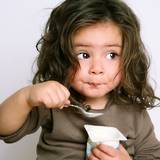Shop
01809
https://www.under5s.co.nz/shop/Hot+Topics+Articles/Health+%26+Wellbeing/Pica+disorder+in+young+kids.html
Pica disorder in young kids
|
Would you know if your kids have pica disorder? Do you know what to look for? Or what causes it? We take a look at pica disorder and how eating non-foods can affect young kids.
|
You might also be interested in ...
Are kids yoghurts doing more harm than good?
Many of us buy yoghurts for our kids because of the widely published health benefits they have, ranging from friendly bacteria to the amount of calcium they contain. But not all yoghurts are created equal! Some types of kids yoghurts have the same amount of sugar and additives in them as chocolate desserts! So how do you tell the difference between 'real' kids yoghurts that offer health benefits from other ‘fake’ kids yoghurts that just taste good?
Party food tips for toddlers & preschoolers
Not sure where to start when it comes to serving party food for toddlers and preschoolers? Here are a few easy tips you can use next time your organising their birthday party.
join usJoin us on social media for all our latest news. |
sign upSign up and receive our latest newsletters. |
|







Do you know what to look for? Or what causes it?
We take a look at pica disorder and how eating non-foods can affect young kids.
Pica disorder in young kids
What is pica disorder?
The word ‘pica’ comes from the Latin word for magpie, a bird that is reputed for its unusual eating behaviours and known to eat almost anything!
Hence pica disorder is characterised by persistent and compulsive cravings (lasting 1 month or longer) to eat non-food items.
It’s not uncommon for young kids under 18 months or so to put everything into their mouths as they explore the world around them. However after this age, repeatedly eating non-foods is generally considered abnormal.
Who is affected by pica disorder?
There is no single test that confirms pica and it often goes unreported. However it’s thought that between 10% - 30% of kids aged 1 to 6 years have the eating disorder.
It appears most commonly amongst young children between the ages of 2 and 3 and in people with developmental disabilities, including autism and mental retardation.
Girls and boys seem to be equally affected.
Why does pica disorder occur?
Unfortunately there is currently no one conclusive reason as to why pica happens or why it occurs in different children for different reasons.
However certain conditions and situations can increase a child's risk; for instance nutritional deficiencies in zinc or iron, developmental problems and mental health conditions.
Pica disorder cravings
Young kids with pica disorder frequently crave and consume non-food items.
Some of the more common cravings include:
Although consumption of particular items may be harmless, pica discorder is considered to be a serious eating disorder that can sometimes result in serious health problems, infection and intestinal blockages.
Fortunately, in most cases, it seems pica disorder is usually a temporary condition that improves as kids get older.
What should you do if you are concerned?
If you think your kids may have pica discorder consult your GP as soon as possible.
They will look into possible causes or triggers and evidence of any harm that’s been done so far.
They may also discuss any signs of autism and intellectual impairment, and possibly do a blood test to check for mineral deficiencies.
Depending on the duration and severity of your kids pica disorder, they may look to refer your child to a paediatrician or child psychiatrist or psychologist.
REMEMBER if your child ever consumes a harmful substance, seek medical care immediately.
More kids articles to enjoy:
- Are kids yoghurts doing more harm than good
- Ways to spot food intolerances in babies & young children
- Guide to baby-led weaning
Image source: thepunch.com.au